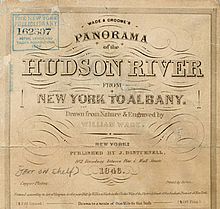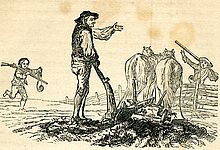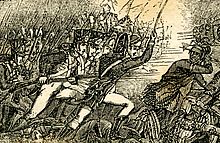William Croome as Book Illustrator
William Croome, 1790-1860, was one of a small colony of artists and engravers of book illustrations in the Brandywine Valley of southeastern Pennsylvania. Croome had been trained in Boston under Abel Bowen and was one of a group of impressive and “raffish” apprentices who went on to fame as engravers and book illustrators. At the time of the publication of Frost’s pictorial history, Croome was a mature artist and one of the Republic’s most busy, designing banknotes, creating covers for Crockett’s Almanacs, and producing illustrations for books. In 1845, just after completion of work for Frost’s Pictorial History, he was engaged in other art projects that promised to make him more money, especially a twelve-foot-long panoramic map illustrating both shores of the Hudson River between Albany and New York City [Image 10] that he and fellow engraver William Wade marketed in plain and colored versions ($1.50 and $2.00 respectively). [17]
Most engravers in the period viewed themselves as essentially copyists, and as such their allegiance was to the “original” and to the abstract principle of fidelity in translation. Later engravers (Croome included) recognized the art of engraving as interpretive and sometimes presumed to add personal touches to an original work of art, but at the time Croome was engraving for Frost, such touches were considered as in violation of the engraver’s mission. Croome used primarily a black-line woodcut style of engraving in which a knife or graver was employed to cut on each side of a line to be inked, the outer contours of the line thus printing black. This type of engraving was best suited to reproduce pen-and-ink or pencil drawings made directly on the block, because “its messages were conceived in units of contour rather than of textural gradients, outlines rather than chiaroscuro.” Hence an illustrator such as Croome was reasonably proficient at reproducing large, blockier forms but found it very difficult to recreate either subtle facial characteristics or textual differentiations of landscape. [Image 11][18]
Expressing depth of picture plane was also a challenge. Croome relied almost exclusively on traditional “profiling” as a means of conveying depth, delineating contour by use of the outer edge of objects as determined by their profile at a maximum extension in space. As a result, his illustrations have a flat, scratchy texture to them, compressing their field of vision and reducing their effectiveness as transmitters of action on the battlefield.[19] As Croome got older he sometimes employed a “freer and more artistic drawing on the block,” but most of his illustrations for Frost’s Pictorial History of the United States had a reportorial or documentary style, aspiring only to provide accurate depictions of persons, places, and things as well as prosaic portraits and conventional depictions of historical episodes.[20] In reviewing Croome’s work, therefore, one is struck by the pervasive two-dimensionality of his illustrations and their glaring failure to create an illusion of a three dimensional world [Image 12].




